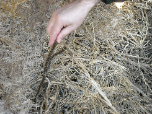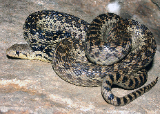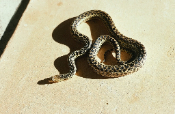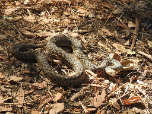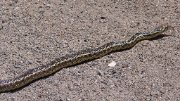Santa Cruz Island Gopher Snake (Pituophis catenifer pumilus)
Description: Adults of the species Pituophis catenifer can be 2.5 - 9 feet long. Hatchlings are fairly long, generally around 15 inches in length, but hatchlings of this subspecies have been recorded at only 6.5 - 9 inches in length. This subspecies, Pituophis catenifer pumilus, is a small or "dwarf" subspecies. Adults only grow to just over 3 feet long. A large snake with heavily keeled scales, a narrow head that is slightly wider than the neck, and a protruding rostral scale on the tip of the snout that is slightly rounded. Ground color is olive, grayish, or brownish with small discrete dark blotches along the back and smaller markings on the sides. The underside is pale and lightly speckled. The back of the neck is dark. There is usually a dark stripe across the head in front of the eyes and a dark stripe from behind each eye to the angle of the jaw. Juveniles tend to have a darker and more compact pattern than adults.
Habitat: Occurs in all types of vegetation found on the islands. Most common in open grassland, dry streambeds, and oak and chaparral woodlands.
Range: This subspecies occurs only on two (possibly three) of the Channel Islands south of the Santa Barbara coast - Santa Cruz and Santa Rosa Islands. There is also an unverified sight record from San Miguel Island.
Found in these States:
CA
Diet: Due to the more limited fauna of the islands, Santa Cruz Island Gophersnakes have a less varied diet than other subspecies of gophersnakes. Their diet probably includes mice, lizards, birds eggs and nestlings. Juveniles probably take small lizards, mice, and possibly insects. A powerful constrictor; kills prey by suffocating them in body coils or by pressing the animal against the walls of their underground burrows.
Reproduction: Mating occurs in spring after emergence from winter hibernation. Females are oviparous, laying one to 2 clutches of 2-24 eggs from June - August. Eggs hatch in 2 - 2.5 months.
Status: The proliferation of feral livestock such as sheep and pigs may have had an impact on populations of this snake by altering the vegetation and landscape. Pigs have also been known to eat snakes. Attempts have been made to remove or eradicate these introduced species.
»» Kingdom: Animalia - Animals
»» Phylum: Chordata - Chordates
»» Subphylum: Vertebrata - Vertebrates
»» Class: Reptilia - Reptiles
»» Order: Squamata - Scaled Reptiles
»» Suborder: Serpentes
»» Superfamily: Colubroidea
»» Family: Colubridae - Colubrids
»» Genus: Pituophis
»» Species: Pituophis catenifer - Gopher Snakes
»» Subspecies: P. c. pumilus - Santa Cruz Island Gopher Snake
This article uses material from the Wikipedia article "Pituophis catenifer", which is released under the Creative Commons Attribution-Share-Alike License 3.0. Content may have been omitted from the original, but no content has been changed or extended.
|


